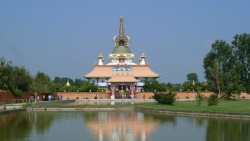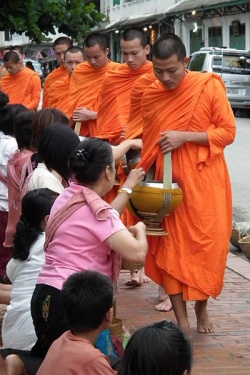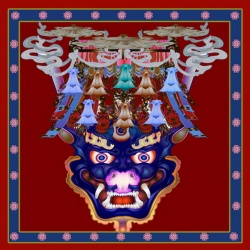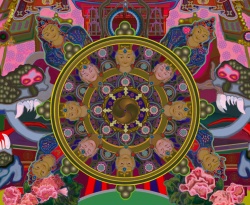Nirvana: Three Takes
Teachers from three Buddhist traditions offer surprisingly divergent views on the meaning of nirvana. Where does your path lead?
By Gil Fronsdal, Tulku Thubten Rinpoche, and Roko Sherry Chayat
In the centuries following the Buddha’s death, dharma teachings spread from India into the rest of Asia, evolving eventually into the three yanas, or vehicles for the teachings—Theravada, Vajrayana, and Mahayana, the predominant traditions of Southeast Asia, Tibet, and East Asia, respectively. The doctrinal distinctions that arose have caused fundamental aspects of what the Buddha taught to be disputed. Even the teachings on such essential matters as karma, enlightenment, and rebirth vary in the three yanas, and from school to school within the yanas—now more so than ever with Western epistemologies stirred into the doctrinal diaspora.
Tricycle editors—and likely lots of other dharma students—are frequently asked for the “Buddhist” take on everything from premarital sex to cloning to cosmetic surgery. The problem is, no single answer emerges from all the branches of Buddhism that have sprouted around the world. A Soto Zen response to the question “Does heaven exist?” diverges drastically from a Pure Land view or a Theravada teaching; even practical questions about how dharma practitioners celebrate the Buddha’s birthday, get married, or care for the dead elicit distinct responses pointing to distinct anniversaries, histories, and rituals, depending on who you ask and where you look.
In an effort to point to the profound variance between “Buddhisms” and teachings,Tricycle takes a look at three basic views of nirvana, its aspects and attainment, from a Theravada, Vajrayana, and a Rinzai Zen (Mahayana) teacher. While Tulku Thubten, a Vajrayana teacher, sees the possibility of sudden, unexpected, and even repeated enlightenment, Gil Fronsdal, a Theravada teacher, has described the process of reaching the “deathless” as akin to desalinating a glass of seawater: the fresh water is there, but getting out the salt—our delusion—is a task of dedication, meticulously applied, over time. And in Zen master Sherry Roko Chayat’s essay, we have enlightenment in “this very moment, this very place; we are 'all done' just as we are.” The differences, perhaps, will speak for themselves. —Mary Talbot
The Good News
In the Theravada tradition the definition of nibbana is simple—the end of suffering.
GIL FRONSDAL
NIBBANA is the ultimate good news of Theravada Buddhism: it means complete liberation. Naturally, people want to know about the nature of nibbana, but from the Theravada standpoint, knowing how a person is transformed in attaining nibbana is more important than understanding what it is.
When a person is thirsty, what’s important about water is not its chemical properties, but that it quenches thirst. Similarly, for someone who is suffering, what’s important about nibbana is not so much its nature but that its attainment extinguishes suffering. Nirvana (Sanskrit) and Nibbana (Pali, the language of the earliest Buddhist texts) literally mean “to go out”—like a fire—and “to cool.” Applied to the mind, it refers to extinguishing the fevers of greed, hate, and delusion, the three roots of suffering. The Buddha’s choice of this term was intimately tied to the imagery of his famous Fire Sermon. Here he said: “Everything is on fire; the eyes are on fire; sights are on fire; visual perception is on fire. . . ; the ears are on fire. . . ; the nose is on fire. . . ; the tongue is on fire. . . ; the body is on fire. . . ; the mind is on fire. . . . They are on fire with greed, hate, and delusion” (from the Mahavagga of the Theravada Vinaya).
In the language of the Buddha, the word for fuel and for clinging is the same:upadana. The Buddha understood that suffering arises from and is fueled by clinging. When the fuel is removed, suffering is extinguished. By understanding how deep-rooted and subtle clinging is in our own unliberated minds, we come to appreciate the mind of nibbana as refreshingly cool and peaceful.
Nibbana is the end of samsara. Contrary to a popular misunderstanding, neither nibbana nor samsara is a place. In attaining nibbana we don’t escape from one location to another. For the Buddha, samsara is the process by which clinging gives rise to suffering which, in turn, gives rise to further clinging. He understood that this self-perpetuating process continues over lifetimes as the “fuel” for rebirth, just as the fire from one burning house is carried to a neighboring house by the wind. Nibbana is what is realized when the clinging of greed, hate, and delusion is brought to an end. Some later Buddhist traditions equate nirvana and samsara. However, they likely attribute very different meanings to these words than those understood by the earliest Buddhist tradition. In Theravada teachings, samsara cannot be nibbana any more than a clenched fist can be an open hand, any more than burning ember in your fist can be the same as letting it go. For the Buddha, nibbana had quite positive associations—after all, it is a simile for ultimate freedom and awakening. At times he used other similes to describe this state: “the blissful, the secure, the pure, the island, the shelter, the harbor, the refuge, the ultimate.”
Other, more perplexing, synonyms include “the unconstructed, the ageless, the deathless, the featureless.” These refer to the idea that nibbana does not exist as something that can be made, shaped, or willed. It is not a “ground of being” from which anything subject to death can arise. Although there is a consciousness, “featureless, infinite, and luminous all around,” that is associated with nibbana, it is not dependent on the conditioned world. Nor does it produce the conditioned world. Rather, it is a dimension of consciousness totally independent of circumstances in the world or in one’s personal life. Because nibbana is independent, people who fully realize it are said to be “unestablished”—in other words, free from any clinging that would confine their consciousness to any point in space or time.
Experiencing nibbana is like taking a dip in a refreshing pond. A quick dip and we are slightly refreshed. With a long soak we are thoroughly refreshed. Even the first, brief dip into nibbana is a powerful lesson in the possibility of a great happiness, freedom, and peace not dependent on the conditions of the world. As long as someone believes happiness can only be found through the right conditions, it makes sense to cling to those conditions—even when knowing full well that all conditioned phenomena are subject to change. But when there is a direct, visceral experience of an alternative, the enchantment that fuels this clinging lessens dramatically. The function of attaining nibbana is to reduce and finally end all clinging. In Theravada Buddhism, the desire to walk the path to nibbana has an honored place. Once that desire is fulfilled, it naturally subsides and the mind clings to nothing, not even to nibbana itself.
Walking the path toward the complete ending of clinging and suffering is the noblest thing a person can do. It opens the fist of the mind, and allows a person to walk in the world with gift-bestowing hands.
Gil Fronsdal has practiced Zen and Vipassana since 1975 and has a Ph.D. in Buddhist Studies from Stanford University. He is the primary teacher for the Insight Meditation Center in Redwood City, California.
Everything is Sacred
Nirvana is awakening to our wise and loving nature.
TULKU THUBTEN RINPOCHE
THE HUMAN MIND has the tendency to manufacture concepts and beliefs in relationship to things that are inherently transcendental. This often leads us to suffer the old curse of “mistaking the finger pointing to the moon for the moon itself.” The cause of this mistaken perception is the ego, since the ego’s only occupation is to sustain its flimsy existence or world of illusion. It always tries its best to create hindrances to the realization of truth.
Every thought about nirvana can be credited to the ego’s attempt to jeopardize one’s entry into nirvana itself. Yet this situation should not cause us to lose hope of discovering nirvana. Many men and women have already realized it. One may know about nectar very well from reading and listening to others’ experiences of tasting it. This is still simply intellectual understanding. One honestly doesn’t know how nectar tastes until it is touched by one’s own tongue. In the same way, you have to directly experience nirvana in order to know its true flavor. This realization requires the dropping of everything that one is shamelessly trying to hold onto. It means a spiritual death—dying to the illusion of self. This is different from physical death.We come across various terminologies and symbols created by spiritual traditions to describe this inner liberation. We even find slightly different ways of understanding nirvana within Buddhism. The point of view within the Vajrayana is that it is an awakened state endowed with wisdom and love. It is ecstatic. It is regarded asmahasukha, which literally means great bliss. This word alone can immediately create a misconception of the true state of liberation. It has nothing to do with ordinary bliss that we experience through our senses, like taking drugs or having sex. It is not necessarily some titillating or altered state of mind that inspires you to frolic in the meadows. Otherwise, hedonism and self-indulgence would be a short cut to enlightenment, which is not the case. The Vajrayana position is to counter the dry notion that nirvana is a dead end: the terminus of every experience from sorrow to bliss. The Vajrayana doctrine regards this as a pseudo-nirvana, which is nothing more than a pain-free vegetative state. It defines awakening as a state that is not only free from sorrow, but also the embodiment of transcendent love, wisdom, and ecstasy.
All schools of thought in Buddhism seem to agree that great cessation is true nirvana. Buddha himself taught that nirvana is the realm of inner peace in which all gross and subtle turbulence of mind has subsided. This comes into being by awakening to the sacred nature of all things. Vajrayana postulates that nirvana is an awakening in which one sees all things as divine, the universe itself as Buddha paradise, living beings as deities. Its unique outlook is that ultimate truth is not just shunyata, or emptiness, but all-pervading sacredness, which is called dakpa rabjamin Tibetan. One of the main features in the Vajrayana practices is to visualize beings as deities in accordance with traditional iconography as a means to gaining realization. Such practice may not be found in other traditions.
Vajrayana starts from the premise that nirvana cannot only manifest in one lifetime, but also at any time—mostly when one is not expecting it. This holds true for both women and men. It’s said that even sinners can be enlightened in one lifetime without incurring the ultimate punishment of being born in hell. The Tibetan saint Milarepa supposedly took the lives of many in his early years through the use of black magic, and then later embraced the spiritual path and became one of the most revered masters in Tibetan Buddhism. There are many people who doubt the existence of nirvana in the first place. This doubt is the product of not finding many examples of those who are enlightened or by the experience of encountering those who are regarded as enlightened by their followers but turn out to be just a big divine joke.
Of course, nirvana is not a myth. It’s a possibility for everyone, but an individual must believe in its existence in order to have any motivation to be on the path to the everlasting freedom. The essence of our consciousness is already love and wisdom. Karma, concepts, and emotional patterns are only temporarily preventing our consciousness from unfolding its enlightened nature. Nirvana is nothing more than being awakened to the enlightened nature of our consciousness. That awakened nature is who we truly are from the very beginning. In accordance with this reasoning, we are destined to be enlightened. If not in this lifetime, then definitely at some point in the distant future.
Tulku Thubten Rinpoche was born in Tibet and was trained in the Nyingma tradition as a young child. He has been teaching in the West since the 1990s and currently serves as the spiritual advisor for the Dharmata Foundation.
ROKO SHERRY CHAYAT explains that enlightenment is already here.
WHAT IS ENLIGHTENMENT? What was it that the young prince of the Shakya clan realized that caused him to be called Buddha, the awakened one?
To answer in the usual discursive, conceptual way cannot convey the truth of this experience, an experience that is not limited to some past event, does not belong to some great historical figure, but is ours to discover. Enlightenment is not a thing, not a condition, not an event, not a goal, not an accomplishment. That which is without limits cannot be defined. Yet the question is a burning one for Buddhists. Even though we may be too hip to ask it, deep down, we want to know what it is that we are practicing. But in truth, we are practicing enlightenment! It is always and already here! There is not a hair’s breadth of separation between what we perceive as our separate, burdensome selves and Buddha-nature. But until this truth has been experienced, a little voice is always asking, “Why?” “What for?” “How come?” We want an answer, we want access to someone else’s understanding, we want some reassurance that what we are doing makes sense. And a good teacher’s response is guaranteed to pull the rug out from under us, to frustrate our acquisitive seeking after the attainment of something outside. Someone asked the great T’ang dynasty teacher Unmon Bunen, “What is Buddha?” Unmon answered, “Shit-wiping stick.” A more modern answer was given by my dharma grandfather, Soen Nakagawa Roshi: “A piece of toilet paper.” This may seem blasphemous: How can one compare Buddha to something that is used to wipe away shit? Indeed, if we think Buddha-nature is that which is sacred, as opposed to everything else that is profane, then of course it sounds blasphemous. But from the vista of realization, what’s blasphemous is making this separation between sacred and profane. This is the same dualistic mindset that creates the fiction of a separate self and condemns us to suffering.
In the Mahaparinirvana Sutra, Shakyamuni Buddha teaches, “All living beings are Buddha-nature,” or, as Zen master Dogen phrased it, “All that there is without anything missing, there-is [is] the Buddha nature.” Shit-wiping stick, toilet paper, birds singing, cars passing by, ants crawling on the ground, itchiness around your ear, sleepiness, everything, all that there is is nothing but Buddha-nature. What is lacking?
The Zen master Rinzai said, “Followers of the Way, it is urgently necessary for you to attain true insight.” And then he continued, “Just don’t strive!” Then what about that urgent necessity for attainment? How do we experience true insight without striving? How do we come to see that this very moment, this very place, just as it is, has nothing lacking, nothing superfluous—that we are “all done” just as we are?
In the fascicle “The Buddha-nature” in his Shobogenzo, Dogen wrote, “The principle of the Buddha-nature is that one’s Buddha-nature remains incomplete as long as one is not awakened, and that it is completed only from the moment one is awakened; the Buddha-nature and awakening can only be simultaneous. You must deeply penetrate this principle in your practice of concentration. Twenty or thirty years of grinding effort are necessary.”
That doesn’t appeal to us. We don’t like the idea of long years of grinding effort. Despite what the Buddha says in the Diamond Sutra—“There is no formula for supreme enlightenment”—we long for some guidelines, some diagram, yes, a formula for quick success. We want what our teachers have, and we want them to give it to us without delay. And therein lies the problem in at least two of its guises: we think there is something to have; and we think it’s good to get something for nothing—when, in fact, this practice of ours requires giving everything for nothing! One of my favorite sayings of Rinzai’s teacher, Obaku, is “Those who seek the Way must enter it with the suddenness of a knife-thrust. Full understanding of this must come before they can enter.” Every koan requires this from us: entering with the suddenness of a knife-thrust, giving everything for nothing, having no preconceived ideas of attainment or accomplishment, just sitting down and emptying the room so that the koan can reveal itself in ourselves, through ourselves, as ourselves. This is effortless effort: difficult, for it flies in the face of all our conditioning; easy, for it requires nothing but an utter giving up and entering into this unlimited, unbounded moment. The more we sit in this dumbfounded way, the more our heart-minds are purified. What we think is the obstacle is the very encouragement we need to open, to give unconditionally, to enter with the swiftness of a knife-thrust into what has never been hidden. This is koan practice. We empty the room, and the Way is everywhere apparent.
When there’s nowhere to turn, nowhere to run, we discover an inner motivation, a strong determination: “I’m going to sit down and shut up. I’m sick and tired of this endless round of confusion and fear. I resolve to enter into the clear, awakened mind of my innate Buddha-nature, so that true compassion can flower, can bloom in my very being.”
Motivation is so important. If we don’t have motivation, of course we’re going to sit there feeling bored, irritated, and in pain. With motivation, we can dedicate our lives: “I am here, fully present, and I vow to wake up fully so that all beings may be released from suffering.” It’s that simple. Vow, and bow, wholeheartedly, and sit down. Then, having entered with “the suddenness of a knife-thrust,” we can drink of the refreshing spring called “the readiness of time.”
Roko Sherry Chayat is the abbot of the Zen Center of Syracuse. She co-edited and co-translated Endless Vow: The Zen Path of Soen Nakagawa and is the editor of Subtle Sound: The Zen Teachings of Maurine Stuart.






